The Crews Hole Wesleyan Chapel of 1860
This chapel stands on the side of the River Avon below Troopers Hill Woods.
The chapel closed during the Second World War. For many years it was hidden from the riverside path by industrial buildings that had been constructed around it. In 2014 these were demolished when the building was converted for residential use.
There is also an earlier Methodist Chapel in Crews Hole, built in 1853, that stands near the bottom of Troopers Hill Road, some information about that chapel and its congregation can be seen here.
Industrial Works to Residential 1990s Onwards
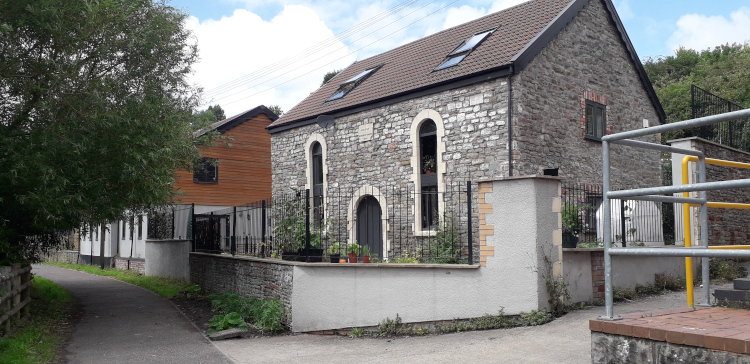
The chapel and part of the 1960s works buildings have now been restored as residential properties. The 2001 view shows the works as it was until 2013.
The older views show the engineering works that were built around the chapel. The Lamb Inn can be seen behind. The 1990s view (or it might be late 1980s) is from two photos taken by Roy, it was taken as work was starting to refurbish the works, which were originally built in the 1960s. Below are two interior shots taken at the same time.
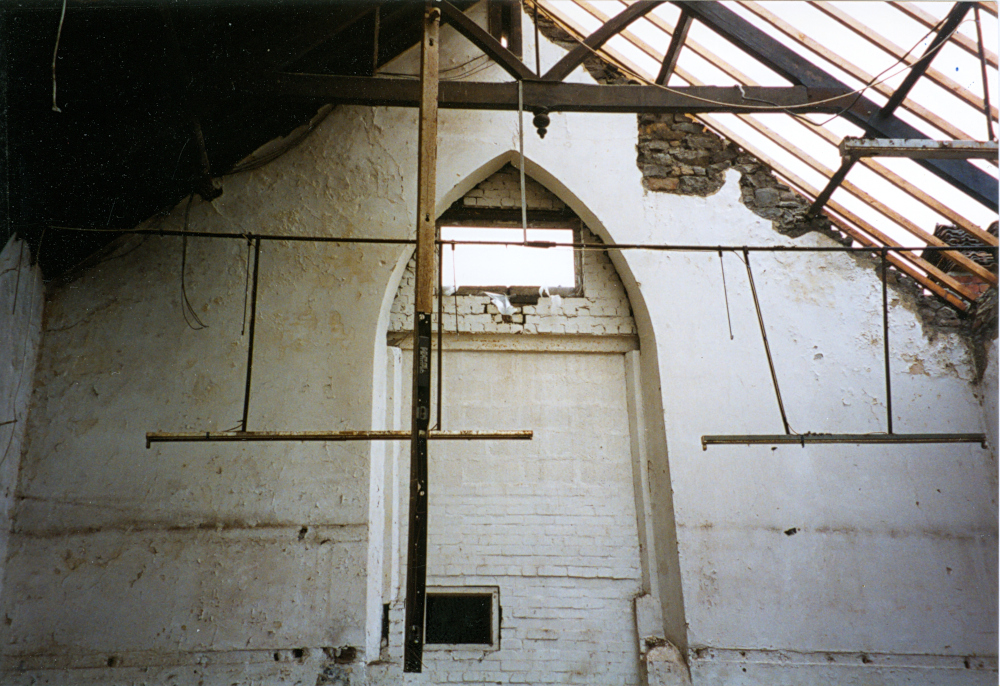
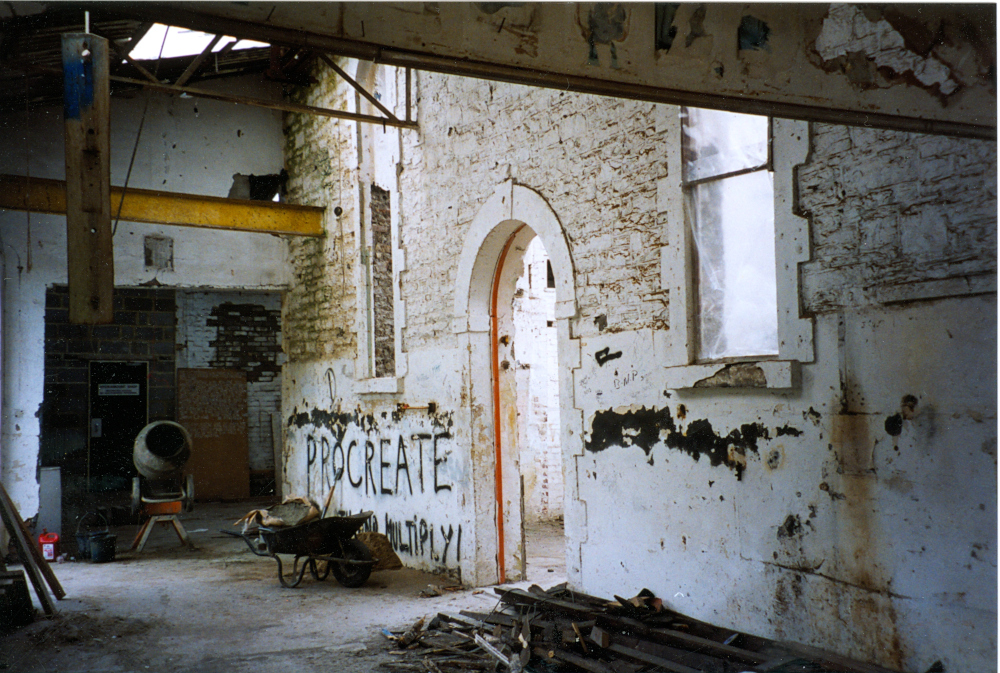
In the early 1990s the Bristol Development Corporation had plans for an Avon Valley Visitor Centre in this area as shown here
Chapel and Adjacent Cottages 1950s
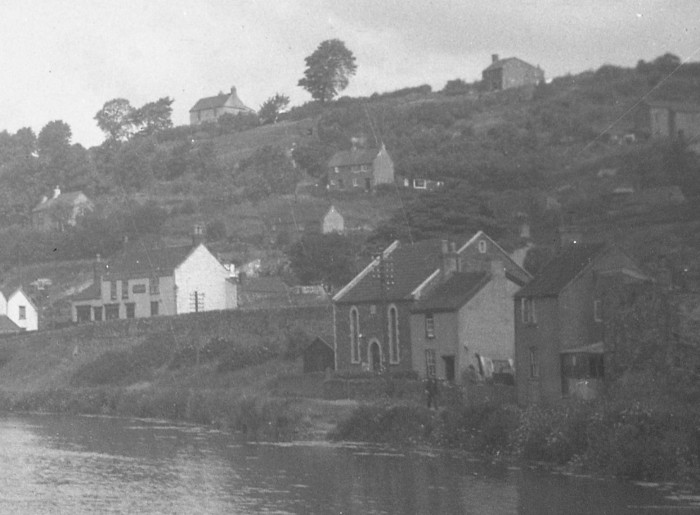
A few years ago, Friends of Troopers Hill were contacted by someone whose father used to live in Crews Hole Rd as a child in a cottage that stood where Didac now is. She remembers a power supply cable to the cottage being installed via a window at the side of the chapel. Her father's name was George Powell born 1911 He also had a sister (Rose) who lived at the bottom of Strawberry Lane. Her grandparents on her father's side were James Powell and Minnie Hares.
The photo above shows that cottage next to the chapel before the industrial works were built. Again the Lamb Inn can be seen in the background. The cottage was probably demolished soon after George Powell passed away in 1958 and it is likely that this was also when the industrial works were built. This image is taken from a photo shared with us by South Gloucestershire Mines Research Group
Construction of the Chapel in 1860
Through Barton Hill History Group, Friends of Troopers Hill were put in contact with Joy Searle, whose family has discovered a collection of pages covering the planning of the Chapel,
purchase of the land and the allocation of the building work to local tradesmen as well as accounts and papers relating to the later running of the chapel. These papers will be passed to the Bristol Archives and a small selection is shown here. They have added to our knowledge of the chapel gained through internet searches and the British Newspaper Archives.
There is a stone on the outside of the chapel that gives the date 1860. This was indeed the year it was constructed; the laying of the foundation stone was cause of a major celebration, the ceremony was reported by the Western Daily Press on 11th September 1860.
The very interesting ceremony of laying the Foundation Stone of a Wesleyan Chapel took place yesterday afternoon, on the banks of the river Avon, Crews Hole, near the Lamb Inn, and fortunately the weather was fine, and a numerous throng of persons assembled.
The report says that the 'throng' included 150 children from the Redfield Wesleyan Chapel Sunday school, who walked in procession with other members of the Redfield congregation to the site, where they were met by another 200 children from the Kingswood Wesleyan Sunday school.
The foundation stone was laid by Archibald Vickers, the manager of the Great Western Cotton Works, he was introduced by the Rev T Stoke who is reported to have said "Mr Vickers, it is well known, has taken a very considerable interest in this undertaking, and to him the inhabitants round about are greatly indebted."
Mr Vickers was then presented with a silver trowel, along with a mahogany mallet and a level.
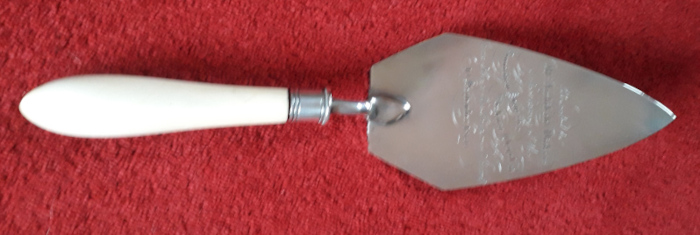
"I have, Mr Vickers, to place in your hands, by the request of the committee, this trowel (presenting a handsome silver trowel!). which will be a remembrance to yourself and to your family of the present interesting service in the days to come"
"The trowel was of solid silver, with an ivory handel, and the following was to be inscribed on it:-
Presented to Mr Archibald Vickers, on the laying of the Foundation Stone of the Wesleyan Chapel, Crew's Hole".
The report gives the names of the contractors who had worked on the chapel as "Mr Smith, builder; Mr Peacock, carpentery work; and Mr David Johnson, painters and plasterers' work"
After the ceremony "About 200 of the friends assembled at Redfield Chapel and partook of a social tea"
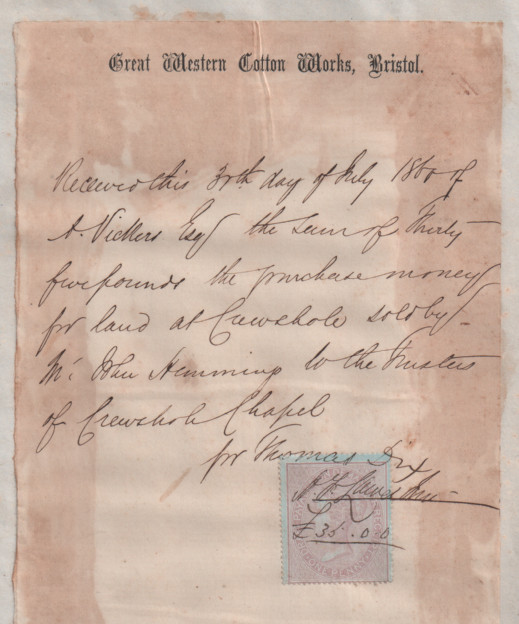
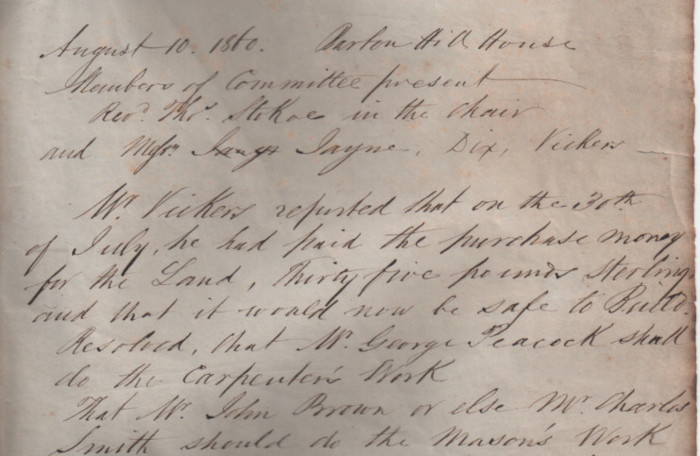
From Joy's papers, above, it can be seen that Mr Vickers paid for the purchase of the land from a Mr John Hemming for £35 on behalf of the Trustees on the 30th July 1860. A meeting called by the Trustees was held at Barton Hill House on 10th August 1860 and was chaired by Thomas Stoke, a Wesleyan clergyman.
The fact that he appears to have paid for the land, might explain why Archibald Vickers was honoured with the laying of the Crews Hole foundation stone.
Running the Chapel
The sheets Joy found are a random collection of papers as mentioned above some referred to the building of the Chapel, but most are copies of accounts and receipted plus other notes that are full of interesing insights into the running of the Chapel.
Joy says, "It looks
as though a quarterly sum of thirteen shillings was given by the Good Templars, a temperance organisation started
in America in the early 1850s to help in communities dealing with heavy alcohol consumption and all its
consequences. Four pounds and twelve shillings per annum was a fair sum at the time, I imagine. It looks as
though they still exist helping today helping those dealing with drug as well as alcohol addiction. It was the
Chapel's main source of funding along with pew rents (9s per annum in 1871), collections and small donations.
The Chapel Keeper's annual salary during this time was two pounds at a time when a labourer earned about 3s 6d
a week, a tradesman about 5s 6d and an engineer 6s.
The bills for regular expenses such as candles, firewood, gas, coal and coke are shown - 12cwt of coal and
firewood 12s 8d, 6cwt coke 2s, 4 kettles 5s 4d. quarterly gas bill for June 17s 7d (1879).
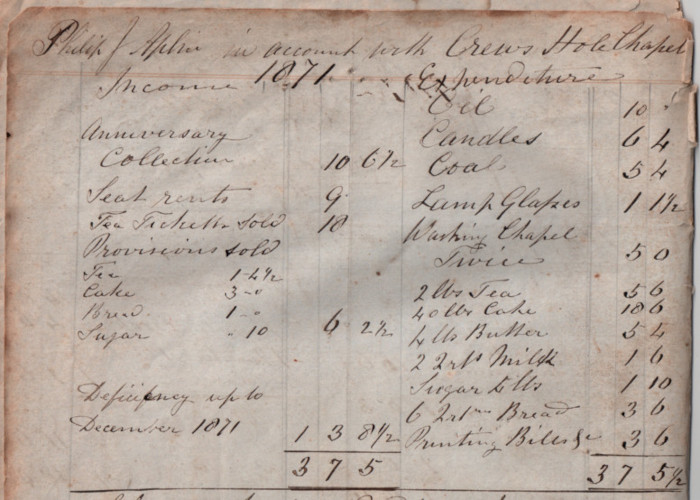
Special anniversary days were held and on these days tea, cake, bread and butter were provided. The accounts
show, in 1871, 5s 6d was spent on 2lbs of tea, 10s 6d on 40lbs of cake, 5s 4d on 4lbs of butter (1s 4d per lb or
about 6 pence in our money today!) 6 times 2 quarterns of bread cost 3s 6d.
In 1874 the Chapel was 'entirely repaired and renovated' at a cost of £22 10s 10d. The work was approved by
Reverend R Dyson and carried out by Samuel Williams. It reopened on 26th April 1874 and the money to pay for
the work was subscribed by "Gentlemen".
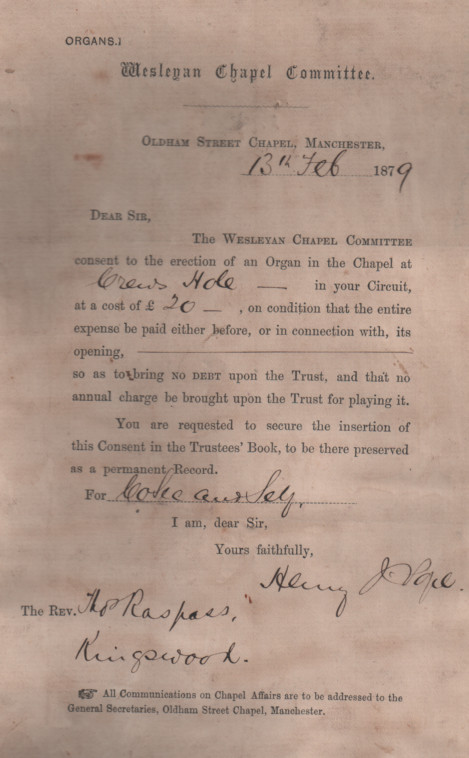
In February 1879 the Trustees were given permission to buy an organ for twenty pounds, to be paid for in
installments. Permission was given by the Weslyan Chapel Committee in Oldham, Manchester.
The "Organ
Opening" was on 4th May, four shillings was spent advertising the event and John Bird carried out the carpentry
work for £7 4s 3d. The music stool cost 7s 6d and it looks as though up until the organ was installed, a harmonium
was used to make music in the Chapel. One was sold by the Trustees for £4 that year. The organ was tuned by John
P Grainger, "Organ Tuner of St George", for 1s 10d."
Archibald Vickers
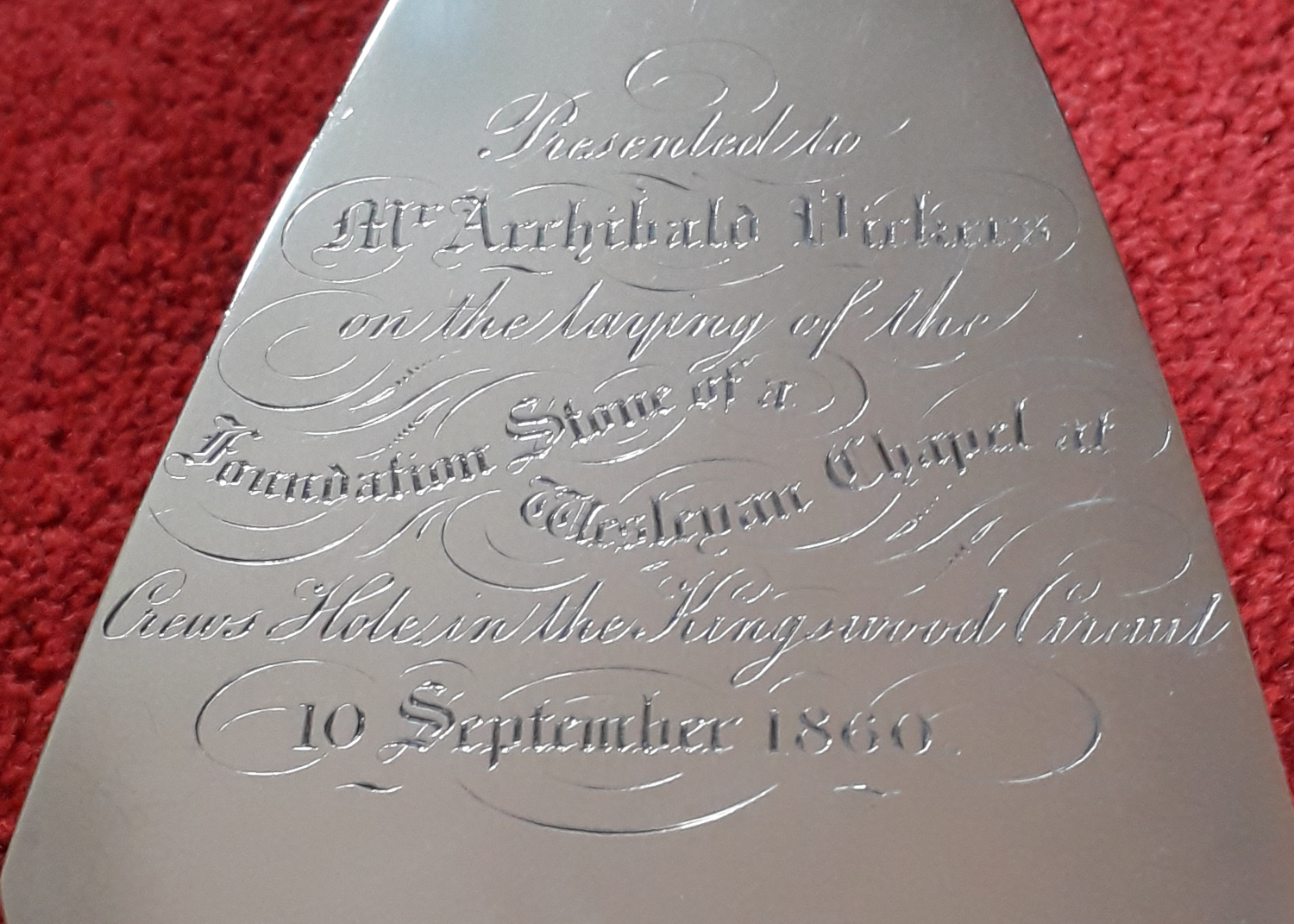
In his acceptance speech Archibald Vickers said
"I feel exceedingly complimented by the kindness of my friends in presenting me with this very hansome silver trowel. I will be a companion to two others which I have received, and will form the centre-piece of the group."
Where did the other presentation trowels come from?
In 1844 the Manchester Courier and Lancashire General Advertiser reported that Archibald Vickers, Esq., of Disley had laid the corner stone of a new Wesleyan school in New Mills. This may have been his first trowel. Five years later there was an article in the Staffordshire Advertiser stating that Archibald Vickers, Esq, of Disley, laid the first stone of a new Wesleyan chapel at Buxton and was presented with a silver trowel by the Mayor of Stockport, James Marshall, Esq.
How did Archibald Vickers move from Disley to Barton Hill?
In the 1851 census he is shown as a cotton manufacturer, living in Waterside, Disley, employing 88 men, 163 women, 108 girls and 65 boys.
In May 1854, Waterside, Disley, the premises formerly in the occupation of Archibald Vickers, including a mill, machinery, mansion house, farm, 72 acres, including a weir with a drop of 15 feet from the river Goit, were for sale.
That August at the Manchester District Court of Bankruptcy Archibald Vickers was given a first class certificate. Mr Commissioner Jemmett spoke of “Mr Vickers well known high character; to his business habits; to the satisfactory style of his book-keeping; to his regular stock-taking; and his honourable conduct throughout.
By 1855 Archibald Vickers has become the manager of the Great Western Cotton Works and in the 1861 census is shown as living at Barton Hill House.
The American Civil War affected the supplies of cotton and in 1862 the works was shut but workers continued to be paid 2 days a week and much was done to support them. Archibald clearly felt strongly about protecting the people he managed and this may have led him to speak out against Abraham Lincoln’s anti-slavery policy, saying at a public meeting in 1863, that the policy was “partial, inhuman, revengeful and altogether opposed to those high and noble principles of State policy which alone should guide the counsels of a great people”.
He appears to have parted company with the Great Western Cotton Works by 1863 when he established two dining halls “on a commercial basis imitating the Glasgow model”. One dining hall was by the Great Western Cotton Works. the other was the Canterbury Hall at St Mary Le Port Street. The aim was to quickly serve food to large numbers at a cheap price. This business venture does not appear to have been successful. In 1865 he was advertising his services as a valuer, inspector, advisor and arbitrator in many newspapers including the Bristol Times and Mirror.
Later, in 1869, he appears as a wine merchant. Things did not appear to go well. In 1876 when he was aged 79, testimonials were run by former colleagues to raise funds for a pension for him. Part of the testimonial reads of his time when the Great Western Cotton Works were shut “that of all the 1,600 workers not one came upon the parish”.
He died in his 81st year in 1879 at Spring Cottage, Fairfield Road, Montpelier, Bristol, His will was proved 5 March 1879 by Margaret Amelia Kerry (wife of Charles Henry Kerry) of Thornleigh, Cromwell Road, Montpelier, the daughter, the sole executrix, his personal estate was valued under £100.









